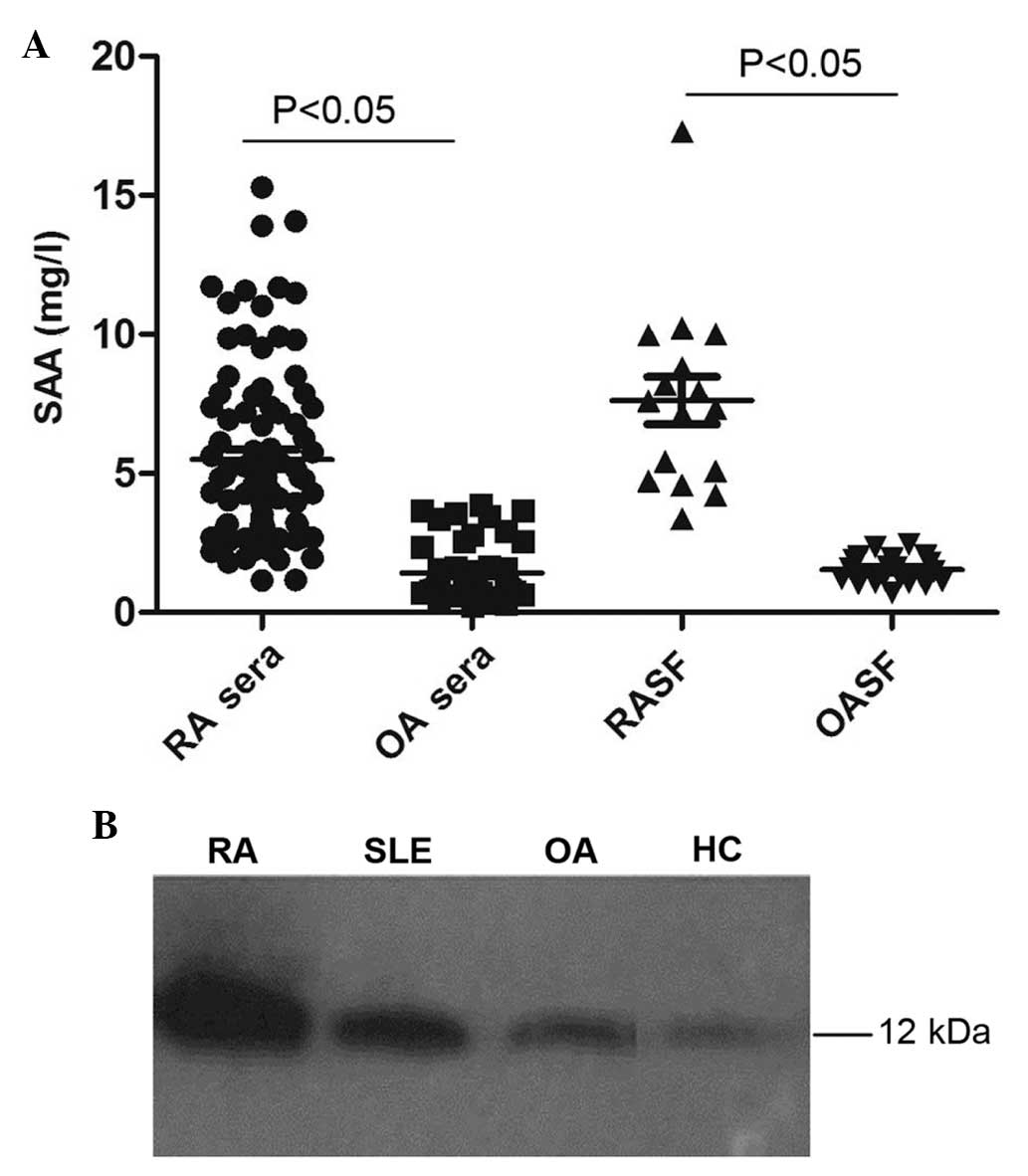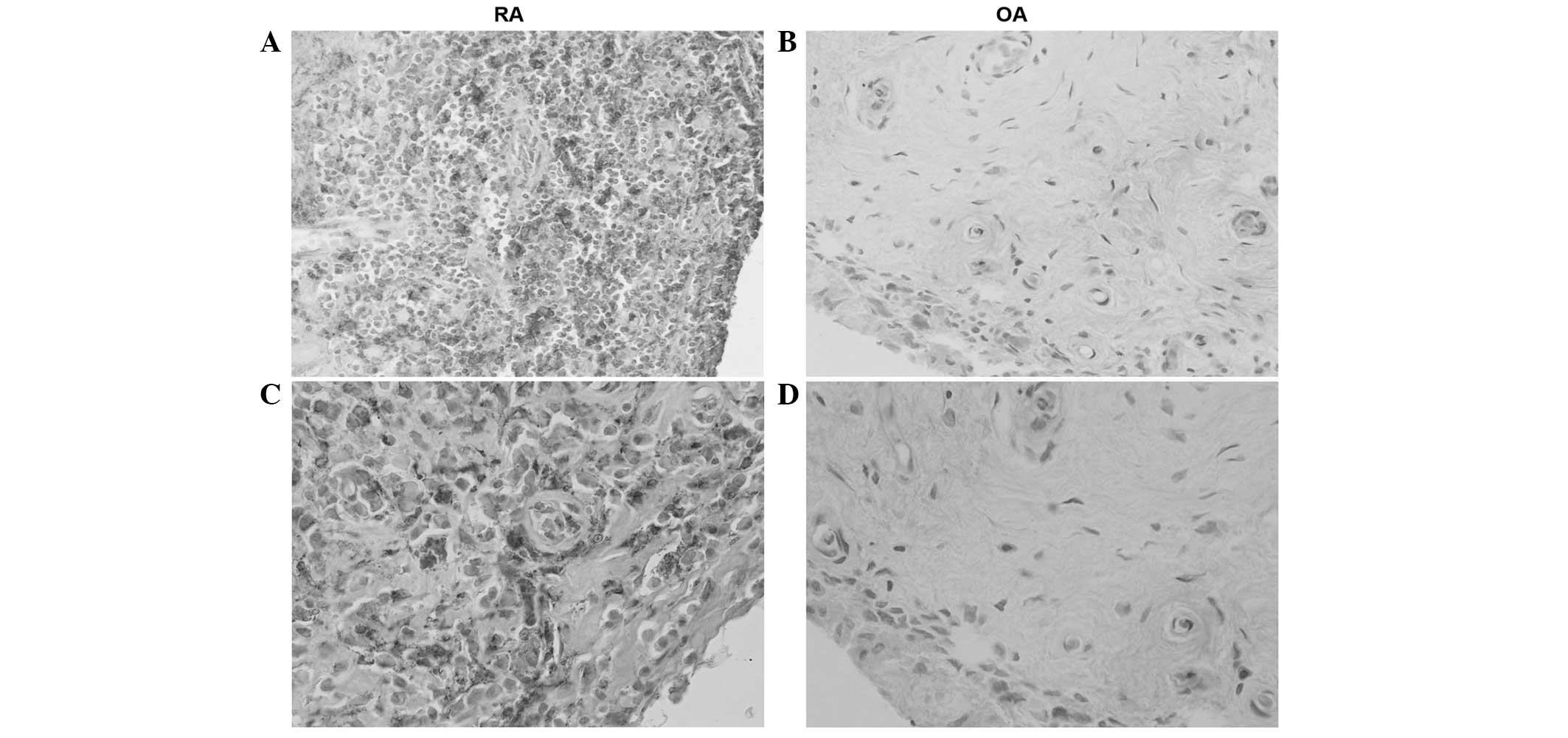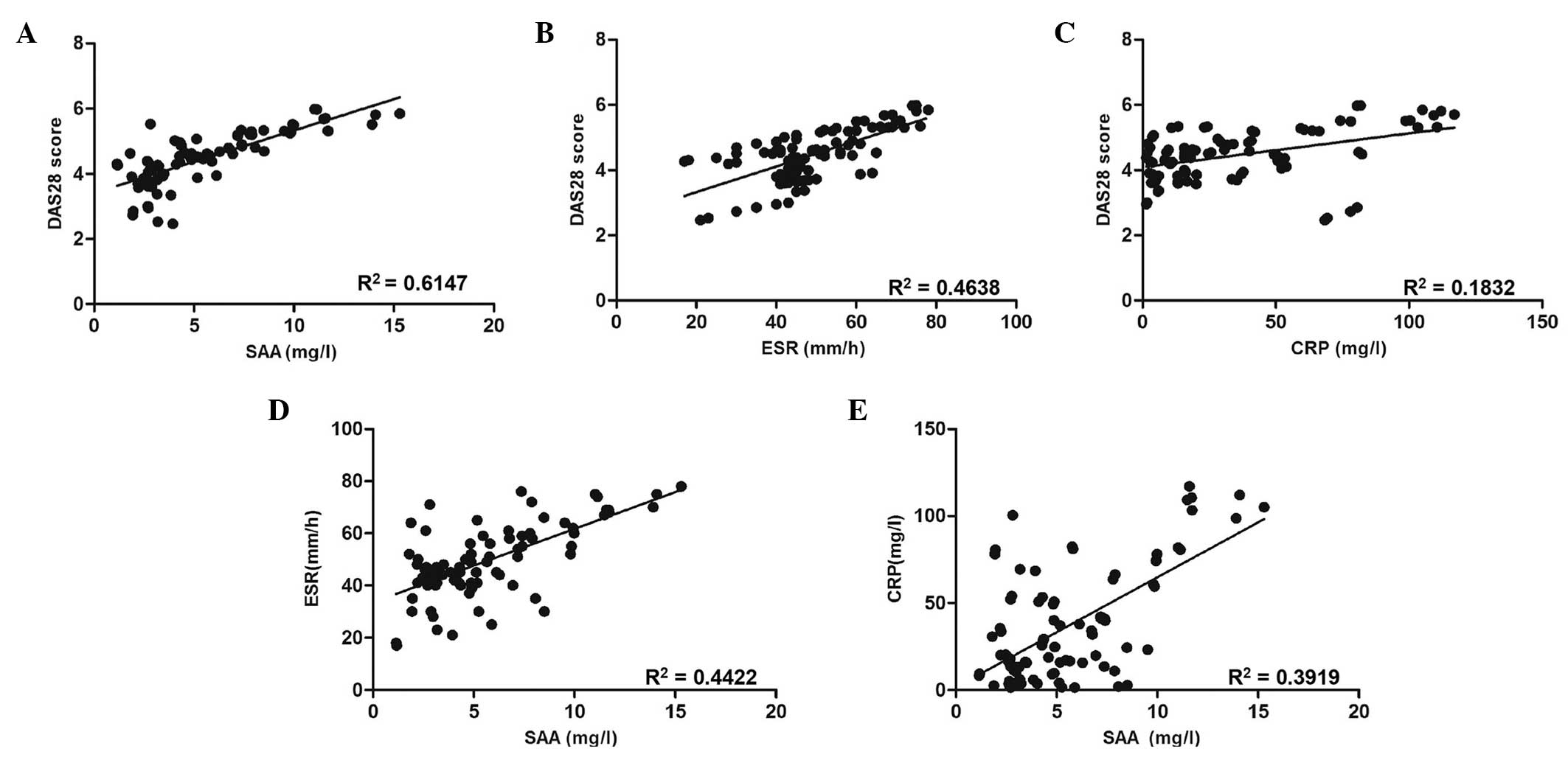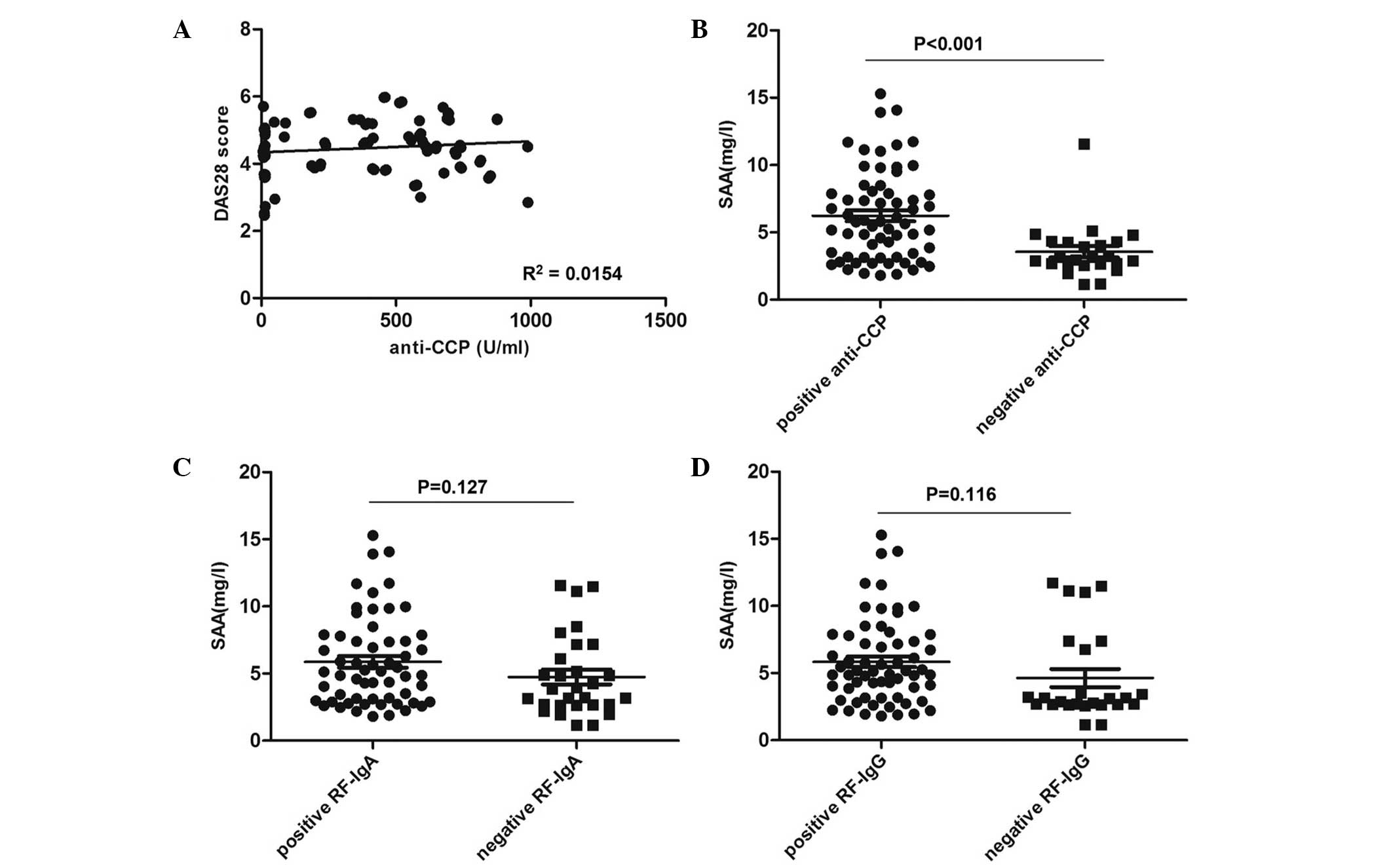Increased serum amyloid A and its association with autoantibodies, acute phase reactants and disease activity in patients with rheumatoid arthritis
- Authors:
- Published online on: October 29, 2014 https://doi.org/10.3892/mmr.2014.2804
- Pages: 1528-1534
Abstract
Introduction
Rheumatoid arthritis (RA) is the most prevalent chronic inflammatory disease, which is characterized by synovial proliferation, progressive damage disability and systemic complications (1). The severity of the disease is associated with inflammation intensity and joint damage (2). The current treatment strategy involves aggressive therapy, which is selected using an assessment of disease activity in pursuit of clinical remission (3). Therefore, determination of disease activity in RA patients has become an important component for RA management.
Several indices have been used to assess RA disease activity based on the clinical manifestations, laboratory and physical measurements. These indices include the disease activity score for 28 joints (DAS28), rheumatoid arthritis disease activity index (RADAI) and clinical disease activity index (CDAI) (3). The majority of RA indices rely on swollen and tender joint counts as well as patient-reported outcomes, of which DAS28 is widely used to monitor and assess disease activity in clinical trials and routine patient care (4,5). However, significant variability occurs between different observers, which influences results. Additional laboratory tests are therefore required in order to augment clinical assessment. Erythrocyte sedimentation rates (ESR) and C-reactive protein (CRP) are both incorporated into disease activity assessments in RA patients (6). ESR and CRP are important inflammatory markers; however, they are reported to be increased with aging and anemia (7). The presence of rheumatoid factor (RF) and anti-cyclic citrullinated peptide antibody (anti-CCP) have been associated with disease severity and joint erosions, which are included in the criteria for RA (9); however, RF and anti-CCP were reported to have little correlation with disease activity (10). Therefore, the elucidation of further surrogate biomarkers for RA disease activity assessment is critical.
Serum amyloid A (SAA) is an acute phase protein, ~12 kDa in size. SAA is primarily synthesized by hepatocytes and secreted from certain extrahepatic sites in chronic inflammatory diseases, including Alzheimer’s disease and RA (10). The circulatory SAA concentration was reported to be significantly increased during acute phase responses, including trauma and infection (11). SAA was also shown to exhibit important immunological functions in the process of inflammation; for example, SAA may be a chemokine for immune cells, including T lymphocytes, neutrophils and mast cells. SAA was also found to stimulate the synthesis of several pro-inflammatory cytokines, including interleukin-1 (IL-1) and tumor necrosis factor (TNF) (12). Previous studies have indicated that SAA positively correlated with disease activity in ankylosing spondylitis (AS) (13), juvenile idiopathic arthritis (JIA) (14) and polymyalgia rheumatica (PMR) (15). The aim of the present study was to investigate the association between circulating levels of SAA and disease activity in RA patients.
Materials and methods
Patients and samples
The types of disease and the respective number of patients that serum samples were obtained from were as follows: RA, 88; osteoarthritis (OA), 54; systemic lupus erythematosus (SLE), 43; and other autoimmune diseases, 30 (Sjogren’s syndrome, 15; ankylosing spondylitis, 5; systemic scleroderma, 5; spondyloarthropathy, 2; psoriatic arthritis, 2; and chondritis, 1), as well as 50 age and gender-matched healthy control subjects (HC) (Table I). Matched synovial fluid (SF) and synovial membrane (SM) samples were obtained from 20 RA and 16 OA patients undergoing arthroscopic biopsies and joint replacement surgeries. All patients with RA fulfilled the American College of Rheumatology (ACR; Atlanta, GA, USA) criteria for RA; in addition, all other patients enrolled in the present study fulfilled their corresponding diagnostic criteria. The present study was approved by the Medical Ethics and Human Clinical Trial Committee of Tianjin Medical University (Tianjin, China).
Sample preparation
All samples, including clotted serum and SF, were centrifuged at 1,425.6 g for 10 min, immediately aliquoted and stored at −80°C. All samples were only allowed to be thawed once.
Determination of SAA levels in sera and SF using ELISA
The concentration of SAA in serum and SF was detected using a sandwich ELISA (human SAA ELISA kit; Xinle Biology Co., Ltd., Shanghai, China) according to the manufacturer’s instructions. Optical density (OD) values of each well were measured using an ELISA plate reader (Multiskan MK3; Thermo Scientific, Waltham, MA, USA) at 450 nm.
Western blot analysis of SAA expression in sera
All serum samples were diluted and denatured at 95°C for 5 min following the addition of loading buffer (Zhaoran Biology Co., Ltd., Shanghai, China). Serum proteins were separated using SDS-PAGE (Zhaoran Biology Co., Ltd.) and subsequently transferred onto the polyvinylidene difluoride (PVDF; Yongyuan Metal Co., Ltd., Suzhou, China) membrane for 1 h at 250 mA. The membrane was then blocked for 1 h at room temperature in 5% skimmed milk/tris-buffered saline with Tween 20 (TBST; 20 mM Tris-HCl, pH 7.6; 137 mM NaCl; and 0.05% Tween 20) and incubated with rabbit anti-human SAA polyclonal antibodies (Abcam, Cambridge, UK) for 1 h at room temperature (1:2,000 in 5% skimmed milk/TBST). The membrane was washed with TBST three times for 30 min each and then incubated with horseradish peroxidase (HRP)-conjugated goat anti-rabbit immunoglobulin (Ig)G (Bioword Technology, Inc., St. Louis Park, MN, USA) for 1 h (1:1,000 in 5% skimmed milk/TBST). Following washing, proteins were detected using a Pierce-enhanced chemiluminescence system (Solarbio Bioscience and Technology Co., Ltd, Shanghai, China).
Immunohistochemistry
Synovial tissue sections were fixed in acetone for 10 min, incubated with primary rabbit polyclonal antibodies against human SAA (1:1,200; Abcam) for 1 h at 37°C. An isotype-matched mouse monoclonal antibody (1:500; Xinle Biology Co., Ltd.) was used as the negative control. HRP-conjugated goat anti-rabbit IgG secondary antibodies (1:1,00) were then added and incubated for 1 h. Color was developed in solutions containing diaminobenzadine-tetrahydrochloride (Sigma-Aldrich, St. Louis, MO, USA) and 0.5% H2O2 in phosphate-buffered saline (pH 7.6; Zhaoran Biology Co., Ltd.). Slides were then counter-stained with hematoxylin and mounted (Zhaoran Biology Co., Ltd.). SAA levels were determined through quantification of the number of positive-staining cells/high-power field.
Determination of disease activity
DAS28-ESR, a validated scoring system for predicting disease activity, was employed in order to calculate disease activity using the following formula: DAS28-ESR=0.56xsqrt(number of tender joints) + 0.28xsqrt(number of swollen joints) + 0.70xLn(ESR) + 0.014xvisual analogue scale (VAS).
VASs are a straight horizontal line of fixed length, usually 100 mm. The ends are defined as the extreme limits of the measured parameter (e.g. symptom, pain and health) orientated from the left (worst) to the right (best). ESR was measured in mm/hr and VAS was measured in mm. The range of the tests varies from 0 to 10.
Clinical and laboratory measurements
General clinical data, including age, gender, disease duration, number of swollen joints and number of tender joints, were collected. Laboratory data were obtained as follows: ESR was measured using the Westergren method (16); CRP was examined using the immunonephelometry method (16); RF-IgA and RF-IgG were measured in serum using rate nephelometry (Immage® Immunochemistry system; Beckman Coulter, Brea, CA, USA). The anti-CCP2 antibody was tested using a second-generation ELISA kit (Shanghai Fuchun-Zhongnan Biotech Co., Ltd, Shanghai, China).
Statistical analysis
Data are presented as the mean ± standard deviation. Data were processed using SPSS 11.0 (SPSS Inc., Chicago, IL, USA). Differences among groups were analyzed using a one-way analysis of variance (ANOVA). Comparisons between two groups were analyzed using a Student-Newman-Keuls test or Student’s t-test. Correlations were determined using the Spearman rank correlation coefficients. P<0.05 was considered to indicate a statistically significant difference between values.
Results
Clinical characters of the participants
Detailed clinical characteristics of all participants are shown in Table I. The data demonstrated no significant differences in gender balance or average age of patients among the groups (P>0.05). However, the results showed that ESR and CRP were significantly increased in the RA group compared to those in the HC and OA groups (P<0.05).
Increased expression of SAA in patients with RA
An ELISA assay was performed in order to detect serum levels of SAA. Data from five groups were analyzed using one-way ANOVA (Table II). The results revealed that there was a statistically significant difference among the five groups (F=5.549; P<0.05). Further statistical analysis, using the Student-Newman-Keuls test, showed that serum SAA levels in RA (6.15±3.27 mg/l) were significantly increased compared to those of the SLE, other autoimmune diseases, OA and HC groups. However, no significant differences were identified among the other groups.
Further ELISA assays were used to detect levels of SAA in SF. As shown in Fig. 1A, SAA levels were significantly increased in the SF of the RA group (7.63±3.39 mg/l) compared to those of the OA group (1.54±0.48 mg/l; P<0.05).
Western blot analysis of serum SAA levels revealed that SAA protein expression levels were markedly increased in RA patients compared with those of individuals in the SLE, OA and HC groups (Fig. 1B).
Immunohistochemical analysis of SAA expression in the SM
Hematoxylin staining revealed high levels of SAA in all tissue samples from RA patients. The histological distribution of SAA was located in synovial lining and sublining layers; of note, in fibroblast-like synovial cells (FLSs), inflammatory cells, vascular endothelial cells and perivascular areas. However, staining for SAA in tissue samples from patients in the OA group was markedly weaker in perivascular areas and FLSs (Fig. 2).
Serum SAA levels correlate with RA disease activity, ESR and CRP
Spearman’s rank correlation analyses were performed to assess correlations between the levels of SAA in RA patients’ sera and DAS28 (Fig. 3A). A significant correlation was observed between SAA levels in sera and DAS28 in RA patients (R2=0.6147; P<0.001), therefore indicating that serum levels of SAA in RA patients were positively correlated with disease activity. In addition, the correlation of serum SAA levels with other serologic biomarkers was assessed. As shown in Fig. 3B and C, ESR and CRP levels were demonstrated to be positively correlated with DAS28 (R2=0.4638, P<0.001; and R2=0.1832, P=0.004, respectively). Furthermore, SAA levels were found to be positively correlated with ESR (R2=0.4422; P<0.001) and CRP (R2=0.3919; P<0.001) (Fig. 3D and E).
Association between SAA and autoantibodies in RA
As shown in Fig. 4A, no significant correlation was identified between serum anti-CCP levels and DAS28 (R2=0.0154; P=0.250). However, RA patients positive for anti-CCP showed significantly increased levels of SAA compared to those of patients negative for anti-CCP (6.88±3.36 and 4.20±2.02 mg/l, respectively; P<0.001) (Fig. 4B). In addition, RA patients positive for RF-IgA demonstrated a non-significant increase in SAA levels compared to those of IgA-negative patients (6.53±3.33 and 5.41±3.00 mg/l, respectively; P=0.127) (Fig. 4C). Identical conclusions were drawn from the results for RF-IgG-positive and -negative groups (6.50±3.17 and 5.29±3.37 mg/l; P=0.116) (Fig. 4D).
Discussion
The aim of the present study was to investigate the association between circulating levels of SAA and disease activity in RA patients. The results showed that SAA levels in RA patients were significantly increased compared to those of the control and other disease groups. In addition, the results of the present study demonstrated a significant correlation between SAA levels and DAS28 as well as other validated disease activity measures; this therefore indicated that SAA was a useful indicator of RA disease activity.
Previous studies have reported that serum SAA levels were elevated in RA patients compared with those of SLE patients (17–19). The results of the present study were consistent with these findings, demonstrating that serum SAA levels were significantly increased not only compared with the SLE group but also with patients with other autoimmune diseases OA and HC; therefore, this implied its potential value for monitoring RA disease activity. The results of the present study were also consistent with a study by de Seny et al (20), which showed significantly elevated plasma SAA levels in RA. SAA is produced via the signaling pathways of pro-inflammatory cytokines, including interleukin (IL)-6 and IL-8 (12). During acute phase responses, including inflammation and infection, SAA concentrations may be elevated as much as 1,000 fold (7). A study by Metawi et al (21) showed that IL-17, secreted by Th17 cells, acted as an indicator of RA disease activity. Another study confirmed that SAA induced the production of CCL20, which has a role in the recruitment of Th17 cells to the inflammatory sites; moreover, the expression of CCL20 was reported to be upregulated by IL-17 (22). These results also suggested the possible role of SAA in disease activity of RA. In the present study, western blot analysis was used in order to determine the expression of SAA in sera, the result of which was consistent with that of the ELISA assays performed. Of note, SAA monomers were located in sera, whereas other forms, including dimers or combined SAA, were not observed.
Furthermore, the results of the present study showed that SAA levels were significantly increased in the synovial fluid and synovial membrane of RA patients compared to those of OA patients; these results were in accordance with previous studies (20,23). Radiographic data revealed that RA patients enrolled in the present study showed signs of cartilage destruction, coarse and erosion (data not shown). It is well-established that SAA in synovial fluid is primarily produced by local joint synoviocytes; in addition, it was reported that SAA messenger RNA was upregulated in RA synovium (17). Okamoto et al (24) demonstrated that SAA activated nuclear factor-κB via binding to the advanced glycation end-product (RAGE) receptor in rheumatoid synovial fibroblasts, which subsequently promoted the expression of pro-inflammatory cytokines IL-6 and IL-8. These results therefore suggested that SAA may have a pathophysiological role in the pathogenesis of RA.
In the present study, a significant correlation was identified between SAA and established disease activity measures. DAS28 is the most commonly used index for assessing disease activity levels in RA patients (25). The results of the present study indicated that SAA correlated with DAS28 (R2=0.6147) in RA. Connolly et al (26) reported that SAA levels correlated with RA disease activity, as measured using swollen joint counts (R2=0.26; P=0.048). In the present study, RA disease activity was calculated using DAS28, which included swollen joint counts, tender joint counts, ESR and VAS. In addition, the patients recruited to the present study were in the stage of acute inflammation with no therapy; by contrast. The patients recruited by Connolly et al were at 0–3 months into anti-tumor necrosis factor a (anti-TNFa) therapy. The results of the present study demonstrated a significant positive correlation between SAA and ESR, CRP as well as disease activity in RA patients. ESR and CRP are both effective indicators of disease activity. It was previously reported that SAA and CRP were primarily produced in the liver; however, serum levels of SAA depend on a greater amount of pro-inflammatory cytokines compared with CRP (27), this therefore suggested that SAA may be a more sensitive biomarker than CRP for reflecting disease activity.
Autoantibodies were suggested to be important for RA diagnosis and prognosis. Anti-CCP is highly sensitive and specific for RA diagnosis, which has been associated with the presence of severe bone erosion (28). In the present study, an association was identified between elevated SAA levels and anti-CCP-positive patients, indicating that SAA may be associated with bone erosion. Increased levels of SAA in RF-IgA and RF-IgG-positive groups were observed; however, these results were not significant compared to those of the negative group. These results may be explained by the low specificity of RF, since RF can also be detected in other infectious diseases, autoimmune diseases and even healthy people.
In conclusion, the results of the present study demonstrated that increased circulating and local SAA levels were significantly correlated with the degree of RA disease activity. These results provided further evidence for the pathological role of SAA in RA, which may be a useful biomarker in the assessment of disease severity and response to therapy. Further studies are required prior to the use of SAA as an indicator of RA disease activity in a clinical environment, for which a larger scale of samples is recommended.
Acknowledgements
The present study was supported by a grant from the Specialized Research Fund for the Doctoral Program of Higher education funded by the Ministry of Education (no. 20101202110008) and the Natural Science Foundation of Tianjin (no. 14JCYBJC25600). The authors would like to thank all subjects for their participation in the present study.
References
|
Scott DL, Wolfe F and Huizinga TW: Rheumatoid arthritis. Lancet. 376:1094–1108. 2010. View Article : Google Scholar : PubMed/NCBI | |
|
McInnes IB and Schett G: The pathogenesis of rheumatoid arthritis. N Engl J Med. 365:2205–2219. 2011. View Article : Google Scholar : PubMed/NCBI | |
|
Emery P: Evidence supporting the benefit of early intervention in rheumatoid arthritis. J Rheumatol. 66:3–8. 2002. | |
|
Fransen J and van Riel PL: The disease activity score and the EULAR response criteria. Clin Exp Rheumatol. 23(5 Suppl 39): S93–S99. 2005.PubMed/NCBI | |
|
Aletaha D, Landewe R, Karonitsch T, et al: EULAR, ACR: Reporting disease activity in clinical trials of patients with rheumatoid arthritis: EULAR/ACR collaborative recommendations. Arthritis Rheum. 59:1371–1377. 2008. View Article : Google Scholar : PubMed/NCBI | |
|
Matsui T, Kuga Y, Kaneko A, et al: Disease Activity Score 28 (DAS28) using C-reactive protein underestimates disease activity and overestimates EULAR response criteria compared with DAS28 using erythrocyte sedimentation rate in a large observational cohort of rheumatoid arthritis patients in Japan. Ann Rheum Dis. 66:1221–1226. 2007. View Article : Google Scholar : PubMed/NCBI | |
|
Da Mota LM, dos Santos Neto LL, Burlingame R, et al: Laboratory characteristics of a cohort of patients with early rheumatoid arthritis. Rev Bras Rheumatol. 50:375–388. 2010. | |
|
Aletaha D, Neogi T, Silman AJ, et al: 2010 Rheumatoid arthritis classification criteria: an American College of Rheumatology/European League Against Rheumatism collaborative initiative. Arthritis Rheum. 62:2569–2581. 2010. View Article : Google Scholar : PubMed/NCBI | |
|
Papadopoulos NG, Tsiaousis GZ, Pavlitou-Tsiontsi A, Giannakou A and Galanopoulou VK: Does the presence of anti-CCP autoantibodies and their serum levels influence the severity and activity in rheumatoid arthritis patients? Clin Rev Allergy Immunol. 34:11–15. 2008. View Article : Google Scholar : PubMed/NCBI | |
|
Mullan RH, Bresnihan B, Golden-Mason L, et al: Acute-phase serum amyloid A stimulation of angiogenesis, leukocyte recruitment, and matrix degradation in rheumatoid arthritis through an NF-κB-dependent signal transduction pathway. Arthritis Rheum. 54:105–114. 2006. View Article : Google Scholar | |
|
Dong Z, Wu T, Qin W, et al: Serum amyloid A directly accelerates the progression of atherosclerosis in apolipoprotein E-deficient mice. Mol Med. 17:1357–1364. 2011. View Article : Google Scholar : PubMed/NCBI | |
|
Eklund KK, Niemi K and Kovanen PT: Immune functions of serum amyloid A. Crit Rev Immunol. 32:335–348. 2012. View Article : Google Scholar : PubMed/NCBI | |
|
Jung SY, Park MC, Park YB and Lee SK: Serum amyloid a as a useful indicator of disease activity in patients with ankylosing spondylitis. Yonsei Med J. 48:218–224. 2007. View Article : Google Scholar : PubMed/NCBI | |
|
Cantarini L, Giani T, Fioravanti A, et al: Serum amyloid A circulating levels and disease activity in patients with juvenile idiopathic arthritis. Yonsei Med J. 53:1045–1048. 2012. View Article : Google Scholar : PubMed/NCBI | |
|
Shimojima Y, Matsuda M, Gono T, Ishii W and Ikeda S: Serum amyloid A as a potent therapeutic marker in a refractory patient with polymyalgia rheumatica. Intern Med. 44:1009–1012. 2005. View Article : Google Scholar : PubMed/NCBI | |
|
Ferrari R, Tanni SE, Caram LM, Corrêa C, Corrêa CR, et al: Three-year follow-up of interleukin 6 and C-reactive protein in chronic obstructive pulmonary disease. Respir Res. 20:14–24. 2013. | |
|
O’Hara R, Murphy EP, Whitehead AS, FitzGerald O and Bresnihan B: Acute-phase serum amyloid A production by rheumatoid arthritis synovial tissue. Arthritis Res. 2:142–144. 2000. View Article : Google Scholar | |
|
Momohara S, Okamoto H and Yamanaka H: Chondrocyte of rheumatoid arthritis serve as a source of intra-articular acute-phase serum amyloid A protein. Clin Chim Acta. 398:155–156. 2008. View Article : Google Scholar : PubMed/NCBI | |
|
Vallon R, Freuler F, Desta-Tsedu N, et al: Serum amyloid A (apoSAA) expression is up-regulated in rheumatoid arthritis and induces transcription of matrix metalloproteinases. J Immunol. 66:2801–2807. 2001. View Article : Google Scholar | |
|
de Seny D, Cobraiville G, Charlier E, et al: Acute-phase serum amyloid a in osteoarthritis: regulatory mechanism and proinflammatory properties. PloS One. 8:e667692013. View Article : Google Scholar : PubMed/NCBI | |
|
Metawi SA, Abbas D, Kamal MM and Ibrahim MK: Serum and synovial fluid levels of interleukin-17 in correlation with disease activity in patients with RA. Clin Rheumatol. 30:1201–1207. 2011. View Article : Google Scholar : PubMed/NCBI | |
|
Migita K, Koga T, Torigoshi T, et al: Serum amyloid A protein stimulates CCL20 production in rheumatoid synoviocytes. Rheumatology (Oxford). 48:741–747. 2009. View Article : Google Scholar | |
|
Mullan RH, Bresnihan B, Golden-Mason L, et al: Acute-phase serum amyloid A stimulation of angiogenesis, leukocyte recruitment, and matrix degradation in rheumatoid arthritis through an NF-κB-dependent signal transduction pathway. Arthritis Rheum. 54:105–114. 2006. View Article : Google Scholar | |
|
Okamoto H, Katagiri Y, Kiire A, Momohara S and Kamatani N: Serum amyloid A activates nuclear factor-kappa B in rheumatoid synovial fibroblasts through binding to receptor of advanced glycation end-products. J Rheumatol. 35:752–756. 2008.PubMed/NCBI | |
|
Farheen K and Agarwal SK: Assessment of disease activity and treatment outcomes in rheumatoid arthritis. J Manag Care Pharm. 17(9 Suppl B): S09–S13. 2011.PubMed/NCBI | |
|
Connolly M, Mullan RH, McCormick J, et al: Acute-phase serum amyloid A regulates tumor necrosis factor α and matrix turnover and predicts disease progression in patients with inflammatory arthritis before and after biologic therapy. Arthritis Rheum. 64:1035–1045. 2012. View Article : Google Scholar | |
|
Thorn CF, Lu ZY and Whitehead AS: Regulation of the human acute phase serum amyloid A genes by tumour necrosis factor-alpha, interleukin-6 and glucocorticoids in hepatic and epithelial cell lines. Scand J Immunol. 59:152–158. 2004. View Article : Google Scholar : PubMed/NCBI | |
|
Agrawal S, Misra R and Aggarwal A: Autoantibodies in rheumatoid arthritis: association with severity of disease in established RA. Clin Rheumatol. 26:201–204. 2007. View Article : Google Scholar |













